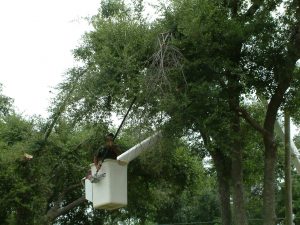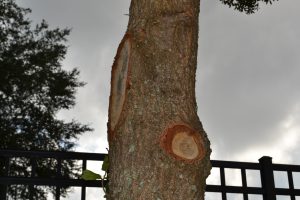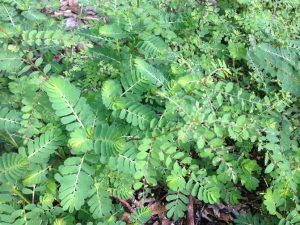by Beth Bolles | Sep 8, 2017
Trees are a valuable resource. They add beauty to our community, serve as food and shelter for animals, filter the air, and cool urban environments. Trees can also be a liability when poorly maintained, damaged, or diseased. There are often times when an arborist is needed to help determine the best course of action for the tree.
There are many individuals who are involved in the tree care and removal business. Not all of these people are certified in the care of trees. Arborists are people who receiving training in the planting, care, and maintenance of trees.

Professional arborists have specialized training to create safe, structurally sound trees, even when damaged by storms. Photo by Beth Bolles, UF IFAS Extension Escambia County
Certified arborists go through a voluntary certification process with the International Society of Arboriculture which means that they have at least three years experience and have passed a comprehensive examination developed by tree experts. A certified arborist maintains certification by attending regular training courses.
An arborist may also be a member of another organization which helps professionals stay up-to-date on tree care techniques and information. These include the National Arborist Association and the American Society of Consulting Arborists.
Hiring an arborist to work on your trees is important for several reasons. An arborist can evaluate the tree and determine the steps necessary to create a healthy specimen. In regards to pruning, the professional will determine what type of pruning is necessary and remove branches properly.
Professionals will also perform tree care practices that are recommended by University research. A few practices that the arborist would not perform include topping trees, using climbing spikes on trees which are not being removed, and making flush cuts against the trunk.

Flush cuts are damaging to trees and can create a future hazard in your landscape. Photo by Beth Bolles, UF IFAS Extension Escambia County
Finally arborists have the skills and equipment to safely and efficiently prune or remove trees. This includes personal and property damage insurance and workers compensation insurance.
Next time you need tree work or advice, hire a professional for the job. It will definitely be worth the investment.
by Ray Bodrey | Sep 8, 2017
Summer annual weeds are taking their last stand against Panhandle lawns before fall arrives. Rain and humid temperatures of late have boosted their growth spurts. Chamberbitter is a prime example.
Chamberbitter (Phyllanthus urinaria) is found as north as Illinois and as west as Texas, but thrives in lower southeastern states. It’s a headache for homeowners as well as pasture managers. This is an annual broadleaf weed that emerges in summer months. The foliage resembles that of the mimosa tree (Albizia julibrissin) and can be confused with the native mimosa groundcover, known as powderpuff mimosa (Mimosa strigillosa). This plant grows upright and develops a long taproot. Wart-like seeds can be found on the underside of the branch.

Figure 1: Chamberbitter, a common annual weed.
Credit: Mary Derrick, UF/IFAS Extension Santa Rosa County.
To control Chamberbitter in a lawn, one must not allow the seed to disperse. This plant germinates in warm soil temperatures. Therefore, it’s best to treat your lawn by applying a pre-emergent herbicide around April. An atrazine herbicide has an 80% effective rate. However, once weeds have germinated, a post-emergent herbicide would need to be applied. Turfgrass herbicides with 2,4-D (with dicamba & mecoprop or MCPP) or atrazine have good results. These are common chemicals and are represented by many brand names. However, both products need to be applied in cooler temperatures. Consecutive days of temperatures of less than 90 degrees are sufficient; otherwise the chemical will harm the turfgrass. Be aware, some formulations will injure or kill centipede and St. Augustine, but are safe to use on bermuda, bahia and zoysia. Be sure to read the label and follow the directions and precautions.
Non-selective, post-emergent herbicides, like glyphosate (Roundup) can be used in thick patches or for spot treatment. When using a non-selective herbicide, remember to protect turfgrass and other plants from spray drift or any contact, especially regarding ornamental plants and trees. Hand pulling of these weeds is an option, especially in flower beds. Do not shake the soil from the roots. In doing so, you may inadvertently spread seeds.
Soon, temperatures will be low enough to use a post-emergent herbicide for a control method. If you are having issues with chamberbitter or other summer annual broadleaf weeds, remember to plan to apply a pre-emergent herbicide this coming spring. Contact Gulf County Extension at 639-3200 for more information.
Information for this article is from the Clemson Cooperative Extension publication: “Chamberbitter”, Bulletin HCIC 2314: http://www.clemson.edu/extension/hgic/pests/pdf/hgic2314.pdf
UF/IFAS Extension is an Equal Opportunity Institution.



